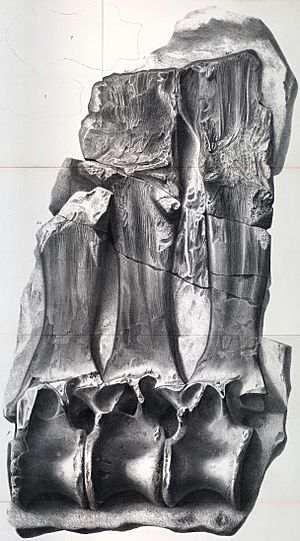Becklespinax facts for kids
Quick facts for kids Altispinax |
|
|---|---|
 |
|
| A drawing from the 1850s of the fossil that helped us learn about Becklespinax. | |
| Scientific classification | |
| Genus: |
Altispinax
|
| Species: |
dunkeri
|
| Synonyms | |
|
|
Becklespinax was a large, meat-eating dinosaur that lived a very long time ago. It was a type of theropod, which means it walked on two legs, just like the famous Tyrannosaurus rex. This dinosaur roamed the Earth during the Early Cretaceous period, about 140 to 133 million years ago.
Scientists found its fossils in Sussex, a county in England. Becklespinax was part of a group of dinosaurs that lived in this area during that time. It was related to another dinosaur called Altispinax, and they likely shared the same ancient landscapes.
Contents
Discovering Becklespinax
The story of Becklespinax began with the discovery of some unique fossils. These fossils included parts of its backbone, specifically some very tall spines. These tall spines are what make Becklespinax stand out!
What the Spines Tell Us
The tall spines on its back might have supported a kind of hump or sail. Scientists are still figuring out exactly what this feature was for. It could have been used to show off to other dinosaurs, to help control its body temperature, or even to store fat like a camel's hump. This special feature makes Becklespinax a fascinating dinosaur to study.
Where and When It Lived
Becklespinax lived in what is now England during the Early Cretaceous period. This was a time when many different types of dinosaurs roamed the land. The environment would have been very different from today, likely warmer and with different kinds of plants.
Its Ancient Home
The area where Becklespinax was found, Sussex, was once part of a large flood plain or coastal area. This means it lived near rivers or the sea, alongside other dinosaurs and ancient creatures. Understanding its habitat helps us imagine what its daily life might have been like.
What Was Becklespinax Like?
As a large predatory theropod, Becklespinax would have been a fearsome hunter. It likely used its strong legs to chase prey and its sharp teeth and claws to catch and eat other animals.
A Powerful Hunter
While we don't have a complete skeleton of Becklespinax, its size and the type of dinosaur it was suggest it was a top predator in its ecosystem. It would have played an important role in the food chain of its time, hunting other dinosaurs or scavenging for food.
Images for kids
See also
 In Spanish: Altispinax dunkeri para niños
In Spanish: Altispinax dunkeri para niños



